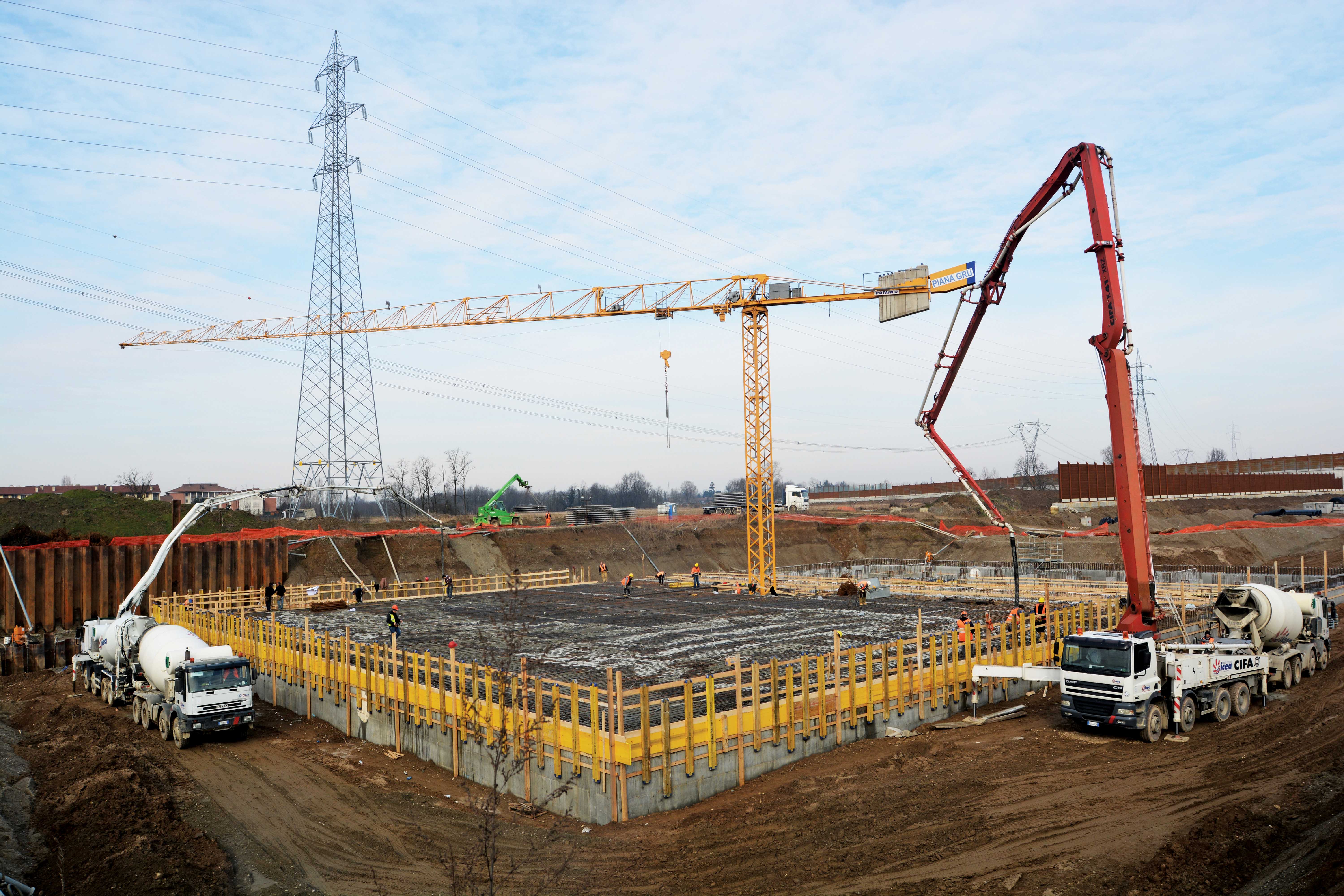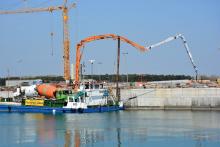Truck-mounted concrete pumps from the manufacturer Cifa have been working around the clock at one of Italy’s most prestigious road infrastructure projects, the Milan Outer Bypass.
The toll motorway project, known by the TEEM acronym from the Italian name Tangenziale Est Esterna di Milano, involves 32km of new carriageway consisting of three lanes in each direction in addition to an emergency lane. The route winds through agricultural land and connects the A4 highway (Milano-Venezia) in the north to the A

Cifa’s truck mounted K41L XRZ cement pump reaches out on site
Truck-mounted concrete pumps from the manufacturer Cifa have been working around the clock at one of Italy’s most prestigious road infrastructure projects, the Milan Outer Bypass.
The toll motorway project, known by the TEEM acronym from the Italian name Tangenziale Est Esterna di Milano, involves 32km of new carriageway consisting of three lanes in each direction in addition to an emergency lane. The route winds through agricultural land and connects the A4 highway (Milano-Venezia) in the north to the A1 highway (Milano-Bologna) in the south.
There are three highway interconnections, six toll booths, 1.2km of tunnels, nearly 2km of viaducts and 7.3km of embankment. Also included are 38km of new local roads, strengthening 15km local roads, construction of 30km of bicycle paths and eight environmental compensation plans.
Construction consortium for the project is Consorzio Tangenziale Engineering. It is an agreement among SPEA – Ingegneria Europea Società per Azioni, Società Iniziative Nazionali Autostradali S.I.N.A., Milano Serravalle Engineering, PROITER (Progetto Infrastrutture Territorio), Technital and also Girpa.
The Milan Outer Bypass lies east of the city and will ease traffic congestion on the famous city’s ring road. Construction has been underway since 2012 and what is completed should greatly help traffic circulation in May when Milan hosts the world fair EXPO 2015.
2203 Cifa’s truck mounted concrete pumps K41L XRZ were working on section Lot B, one of the first sections to be completed and which runs through agriculturally important municipalities including Gorgonzola, Bellinzago Lombardo, Liscate and Zelo Buon Persico.
The concrete casting contract, managed by the company Icea, covers all the production, transportation and laying activity for every any kind of mix, from cemented mix to special concrete for any kind of casting. It is done on behalf of the lot main contractor Arco TEEM Consortium. Among the work is the casting of a large laminated water holding tank.
For the casting of around 700m3 of concrete, the company Belpasso (Catania province) chose the K41L XRZ to be fed by an array of Cifa mixers to ensure a continuous flow of concrete from the company’s production plant to the casting site.
K41L XRZ was chosen by Icea for its operative versatility and hourly production rate of 140m3/hr. It also has a horizontal opening that reaches more than 35m thanks to the five- section, according to the owner of Icea, Angelo Di Fede. “We are specialists in the concrete production supply chain and, as such, we need to guarantee a problem-free turnkey service. In this Cifa, with its machines and assistance, gives us a big hand.”
Despite being acknowledged as having severe traffic congestion, last year Milan won the 2014 Transport Achievement Award for its ‘Area C’ urban road pricing scheme.
The TAA is awarded annually by the1102 International Transport Forum, part of the OECD and an intergovernmental organisation for the transport sector. Milan, said by the ITF to be one of the most car-dependent cities in Europe, is among only a few European cities to have introduced a road pricing measure.
This measure, known as ‘Area C’, was introduced in January 2012, following a referendum in which nearly 80% of voters supported the upgrade of an existing, limited charge to cover more vehicles and also a wider area.
Cars entering Milan’s ‘Area C’ are detected by a system of 43 electronic gates equipped with Automatic Number Plate Recognition (ANPR) technology. The fee charged per entry is €5. Mopeds, motorcycles, electric cars, vehicles for disabled people as well as some other vehicle categories are exempted. Residents have 40 free accesses per year and pay €2 from the 41st access.
The programme has reduced congestion, with vehicle accesses to ‘Area C’ falling by 28% compared to levels prior to its introduction. Demand for on-street parking is down by 10% and productivity for freight deliveries within Milan has increased by 10%. The number of road crashes with injuries fell by 26.3%.
Emissions were also reduced: Particulate Matter by 10% and CO2 by 35%. The speed of public transport increased (buses by 6.9%, trams by +4.1%). Cars using ‘Area C’ were less polluting, with the share of cleaner vehicles rising from 9.6% of the total to 16.6%.
The toll motorway project, known by the TEEM acronym from the Italian name Tangenziale Est Esterna di Milano, involves 32km of new carriageway consisting of three lanes in each direction in addition to an emergency lane. The route winds through agricultural land and connects the A4 highway (Milano-Venezia) in the north to the A1 highway (Milano-Bologna) in the south.
There are three highway interconnections, six toll booths, 1.2km of tunnels, nearly 2km of viaducts and 7.3km of embankment. Also included are 38km of new local roads, strengthening 15km local roads, construction of 30km of bicycle paths and eight environmental compensation plans.
Construction consortium for the project is Consorzio Tangenziale Engineering. It is an agreement among SPEA – Ingegneria Europea Società per Azioni, Società Iniziative Nazionali Autostradali S.I.N.A., Milano Serravalle Engineering, PROITER (Progetto Infrastrutture Territorio), Technital and also Girpa.
The Milan Outer Bypass lies east of the city and will ease traffic congestion on the famous city’s ring road. Construction has been underway since 2012 and what is completed should greatly help traffic circulation in May when Milan hosts the world fair EXPO 2015.
The concrete casting contract, managed by the company Icea, covers all the production, transportation and laying activity for every any kind of mix, from cemented mix to special concrete for any kind of casting. It is done on behalf of the lot main contractor Arco TEEM Consortium. Among the work is the casting of a large laminated water holding tank.
For the casting of around 700m3 of concrete, the company Belpasso (Catania province) chose the K41L XRZ to be fed by an array of Cifa mixers to ensure a continuous flow of concrete from the company’s production plant to the casting site.
K41L XRZ was chosen by Icea for its operative versatility and hourly production rate of 140m3/hr. It also has a horizontal opening that reaches more than 35m thanks to the five- section, according to the owner of Icea, Angelo Di Fede. “We are specialists in the concrete production supply chain and, as such, we need to guarantee a problem-free turnkey service. In this Cifa, with its machines and assistance, gives us a big hand.”
Despite being acknowledged as having severe traffic congestion, last year Milan won the 2014 Transport Achievement Award for its ‘Area C’ urban road pricing scheme.
The TAA is awarded annually by the
This measure, known as ‘Area C’, was introduced in January 2012, following a referendum in which nearly 80% of voters supported the upgrade of an existing, limited charge to cover more vehicles and also a wider area.
Cars entering Milan’s ‘Area C’ are detected by a system of 43 electronic gates equipped with Automatic Number Plate Recognition (ANPR) technology. The fee charged per entry is €5. Mopeds, motorcycles, electric cars, vehicles for disabled people as well as some other vehicle categories are exempted. Residents have 40 free accesses per year and pay €2 from the 41st access.
The programme has reduced congestion, with vehicle accesses to ‘Area C’ falling by 28% compared to levels prior to its introduction. Demand for on-street parking is down by 10% and productivity for freight deliveries within Milan has increased by 10%. The number of road crashes with injuries fell by 26.3%.
Emissions were also reduced: Particulate Matter by 10% and CO2 by 35%. The speed of public transport increased (buses by 6.9%, trams by +4.1%). Cars using ‘Area C’ were less polluting, with the share of cleaner vehicles rising from 9.6% of the total to 16.6%.





